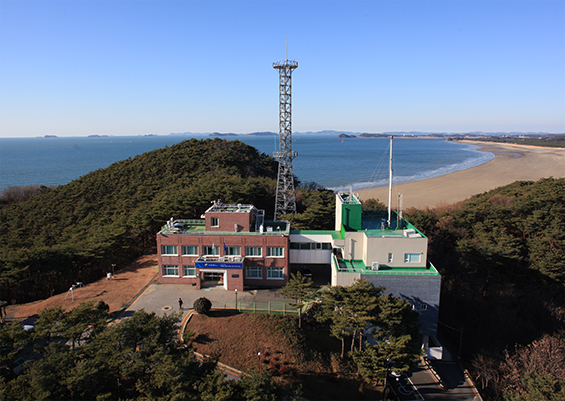
Sampling site: Anmyeondo (36.54°N, 126.33°E, 46 m a.s.l.) is
located in the western part of the
Korean Peninsula and has monitored SF6 since 2007.
It has seen a dynamic and wide range of
SF6 mole fractions according to wind direction.
The station has a 40 m tower behind the main building,
and it is connected to a gas sampling system
with a decabon tube for tertiary standard gases.
Samples are collected when the air mass comes
from the south or the west.
Our system for cylinder preparations
Cylinders :
A high-pressure aluminum cylinder (30 L) is used because aluminum has low absorptivity and reactivity towards gas.
Cylindrical vacuum pumping system :
The cylindrical vacuum pumping system is capable of vacuum processing up to 10-3,which is
the Pa level inside the cylinder used for ambient air sampling.
The system includes a turbo molecular pump and a heating jacket that can remove moisture inside the cylinder by keeping the temperature at a constant ~ 60°C.
Compressor :
When sampling in a high-pressure cylinder, an SA-3E series air compressor (RIX Industries, Benicia, CA, U.S.A.) is used
as an oil-free piston-type pump. Additionally, a pressure sensor is embedded in the compressor so that it can be turned off when the
pre-determined pressure level has been reached (1500 psi), thus preventing collection of samples under excessively high pressure.
As a safety measure, a relief valve that releases gas when pressure exceeds 1700 psi should also be mounted to the compressor.
Dry air collection system :
The dry air collection system is mounted between the compressor and the cylinder.
Its components include a moisture trap, which removes atmospheric moisture; a pressure gauge, which can measure
the filling pressure of a cylinder or canister; a relief valve for safety; and a check valve, which prevents samples from reflowing.
- Moisture trap and compressor :
Moisture traps are made by filling a stainless steel tube with a moisture absorbent,
such as magnesium perchlorate (Mg(ClO4)2), and mounting a dust filter (7 μm) at the bottom of the trap.
A granule-type moisture absorbent of 8–12 mesh Mg(ClO4)2 is used. We do not use Mg(ClO4)2 for more than 24 hours after the moisture
absorbent is filled. Also, we change the VCR gaskets, which are used at the inlet and the outlet of the moisture trap. - Pressure gauge and relief valve :
The pressure gauge monitors internal pressure in the collection system and cylinder during sampling and keeps the sampling pressure below the maximum pressure allowable for high-pressure cylinders.
The relief valve controls the pressure in high-pressure cylinders so they do not exceed their respective maximum pressures.

Schematic diagram (left) and the picture (right) of the dry air collection system installed at AMY
Spiking/diluting system :
The WCC-SF6 spiking/diluting system is able to safely control pressure of up to 100 atm (1,470 psi)
with displays attached for a high pressure sensor (④, Max. 0-3000 psia) and a low pressure sensor (③, Max. 0-500 psia), respectively.
As seen in Figure 4, four pressure control valves (⑦ V1, ⑩ V2, ⑧ V3, and ⑨ V4) and a purge vent valve (⑪) have been attached.
Since the s.s.lines of most gas mixture producers are 1/8” in diameter, the use of long lines with such a narrow inlet diameter makes
it hard to remove polluted air from the lines even when a vacuum pump is used to evacuate the air.
The WCC-SF6 system, however, has a purge valve to allow mother gas (①) gradually to flow into and out of the purge valve attached
to the end of the sampling cylinder valve (②), easily eliminating polluted air. In addition, improper operation may generate high
pressure that can burst or break the low-pressure sensor since it can handle a maximum pressure of 0-500 psia. Accordingly,
a safety valve has been installed in front of the pressure sensor so that the valve will open at a pressure of about 400 psia,
while closing the V3 valve (⑧) and allowing high pressure to be used if low pressure is not used.

Schematic diagram (left) and the picture (right) of the spiking/diluting system installed at AMY
Analysis system :
The Gas chromatography with Electron Capture Detector (Agilent 7890) was used to assign mole fractions.
Configuration of analytical system used in this key comparison is as follows;
Gas cylinder → regulator → MFC → Pre-concentration →sample injection valve → column → detector → integrator (Chemstation)
→ area comparison → results.
Analytical condition of instrument used to measure SF6
| Instrument | Analytical condition |
|---|---|
| Detector | µECD (Agilent 7890A) |
| Detector Temp | 375 ℃ |
| Main carrier gas | P5, 70 psi, 45℃ |
| BF carrier gas | P5, 70 psi, 45℃ |
| Sample loop size | Trap size (2 cc) |
| Sample flow | 100 ml/min |
| Total runtime | 34.5 min |
| Peak retention time | 6.830 min |

Analysis system at AMY

